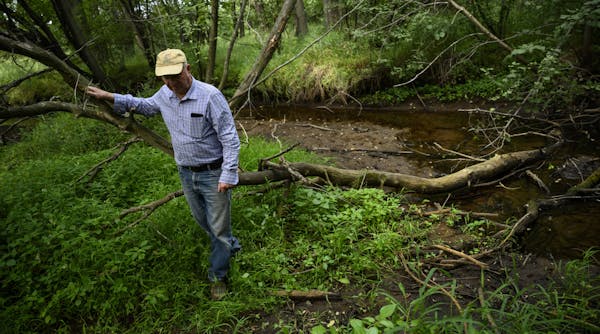DULUTH – Until recently, the cold, pristine waters of Lake Superior have not been ideal habitat for harmful algae blooms. But with warming waters and changing precipitation patterns, the potentially hazardous pond scum is becoming more common on the big lake.
This year at least six algae blooms were reported on the western arm of Lake Superior, according to the Wisconsin Department of Natural Resources. Cyanobacteria, also known as blue-green algae, took advantage of warm surface water and ample sunlight to develop into soupy masses along shorelines from the Apostle Islands to Thunder Bay in July.
Most recently, a bloom was spotted last week at Barker's Island beach in Superior, Wis., closing the swimming area to the public.
Contact with algae blooms can be toxic to humans and pets and can also disrupt marine life. Though the blooms are commonly found on warmer, shallower lakes, their presence on Lake Superior has researchers concerned for the long-term outlook of a massive body of water that is already among the fastest-warming lakes in the world.
"Are things changing in the lake, and are we seeing a shift?" said Kaitlin Reinl, a researcher at the University of Wisconsin Madison who has extensively studied algae blooms in Lake Superior. "It could make us sick, but the lake is also a very important cultural and spiritual resource. How might this change access for future generations?"
The first documented algae bloom in Lake Superior was in 2012, and there have been blooms reported in several years since. Though researchers are trying to determine if there were blooms before 2012, the effects of climate change makes it more likely that they will continue to occur.
"In general, high surface water temperatures may promote blooms," said Gina LaLiberte, the Wisconsin DNR's harmful algal bloom coordinator; this year has seen much warmer water in Lake Superior than in a typical year.
"Blooms are most likely to accumulate in the nearshore zone when waves are calm, which allows buoyant cyanobacteria to float at or just below the surface, LaLiberte said. "Gentle winds toward shore can then blow the cyanobacteria toward the beach, concentrating them into cloudy green water conditions."
In 2016, 2017 and 2021, warmer surface water temperatures caused smaller, more dispersed blooms to form.
In 2012 and 2018 the lake saw major storms — which are becoming more common — that led to a huge increase in nutrients in the lake and caused larger algae blooms to thrive.
It is also likely that the lake's tributaries host dormant algae cells that can proliferate in the right conditions in Lake Superior.
"One year it's one thing, another year it's something else driving the blooms," Reinl said. "There are a lot of pieces to this puzzle, but this year is following the pattern."
To prevent blooms, Reinl said making shorelines resilient against destructive storms can help keep runoff minimal. Keeping temperatures lower is also vital.
"How are we supposed to affect global, regional air temperatures?" she said. "Doing those things that limit your carbon footprint and contributions to greenhouse gases. We shouldn't overlook that."
On Wednesday, the surface temperature of western Lake Superior was in the mid-60s, several degrees warmer than is typical for this time of year, according to satellite data from the National Oceanic and Atmospheric Administration that stretches back to 2007.
Most recorded blooms on Lake Superior occur earlier in the summer, though other waters can still produce them.
"Blooms may occur through early fall, especially in inland lakes, so people should continue to keep an eye out for bloom conditions before recreating," LaLiberte said. "More concentrated cyanobacterial blooms in inland Minnesota and Wisconsin lakes may resemble spilled paint, opaque 'pea soup,' or black or vividly colored floating mats."
Contact with algae blooms should be avoided; report sightings to algae.mpca@state.mn.us or dnrhabs@wisconsin.gov.
Brooks Johnson • 218-491-6496

A plume of PFAS chemicals under the east metro is moving. The state has a new plan to stop it.

Andover High School teacher leads effort for more understandable driver's tests

Trail section at one of Minnesota's most iconic spots closing for rehab

Will 'shotgun only' zone for deer in southern Minnesota be abolished?

